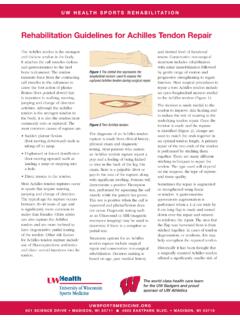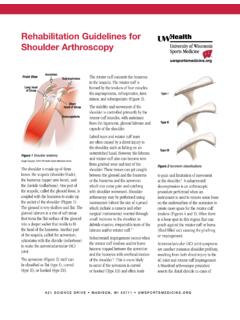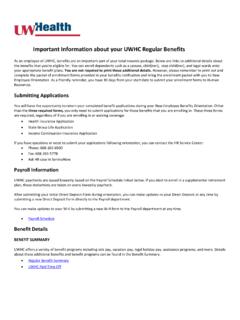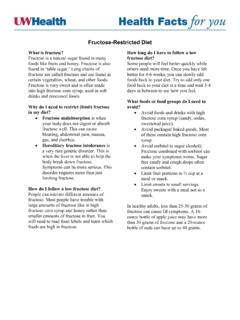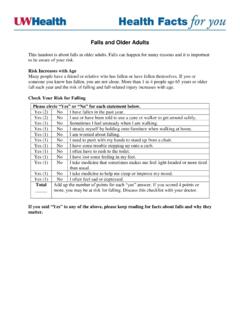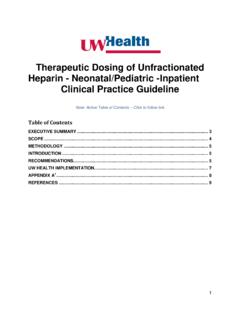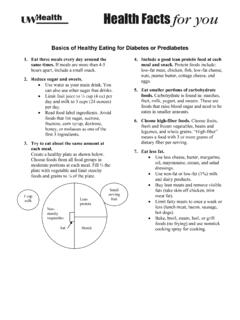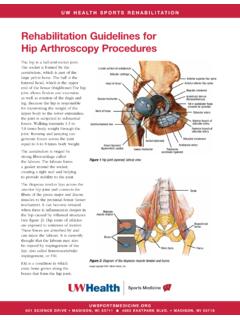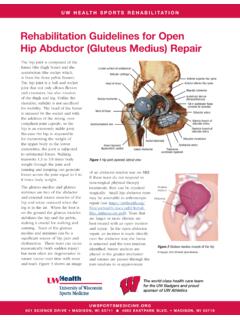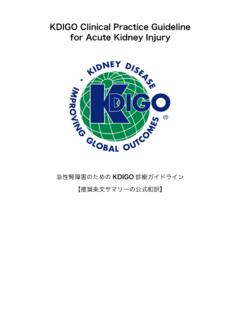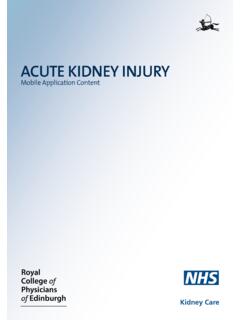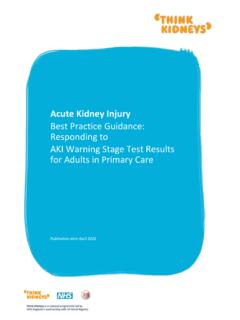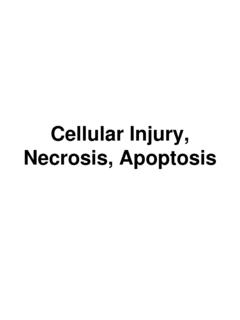Transcription of Vasoactive Continuous Infusions - Adult - Inpatient Guideline
1 1 Vasoactive Continuous Infusions in Adult Patients Adult Inpatient Clinical Practice Guideline Table of Contents Summary .. 2 .. 4 .. 4 .. 4 .. 5 Implementation .. 10 .. 12 CPG Contact: Name: Philip Trapskin, PharmD, BCPS, Drug Policy Manager Phone Number: 608-265-0341 Email address: Guideline Author(s): Updated by Melissa Heim, PharmD and Jeff Fish, PharmD Anna Krupp, RN, MS Cindy Gaston, PharmD Coordinating Team Members: A. Alexander, CNS, MS; S. Aton, PharmD; J. Fish, PharmD, S. Kraus, MS, RN; M. Murray, CNS,MS; Critical Care CommitteeReview Individuals/Bodies: M. Heim, PharmD; C. Gaston, PharmD; J. Fish, PharmD; A. Krupp RNCommittee Approvals/Dates: Critical Care Committee August 2014 Original Guideline approved by Pharmacy & Therapeutics Committee: May 2010 Revised Guideline : October 2014 Release Date: October 2014 Copyright 2014 University of Wisconsin Hospitals and Clinics AuthorityContact: Lee Vermeulen, Last Revised: SummaryGuideline Overview The purpose of this Guideline is to provide a framework for the ordering, initiation and titration of specific Vasoactive agents in critically ill adults Practice Recommendations recommendations regarding Treat the underlying cause of cardiovascular instability, hypoxia and acidosis and fluidresuscitate patients to response along with Vasoactive agents 2,10 (Class I, Level A) Consider a second vasopressor when one is not effective10,11 (Class I, Level B) Use norepinephrine as the first line agent in the treatment of hypotension due to septicshock10,12,13 (Class I, Level A) Central line preferred, however, peripheral/intraosseous access may be used when benefit outweighs risks14,15 (Class I, Level C) Add vasopressin to norepinephrine in patients with septic shock and insufficient response tonorepinephrine with the intent of raising mean arterial pressure to target or decreasing norepinephrine dosage4,10 (Class I, Level A)
2 Central line preferred, however, peripheral/intraosseous access may be used when benefit outweighs risks14,15 (Class I, Level C) Use epinephrine as the first line agent for patients with anaphylaxis16,17 (Class I, Level A) Epinephrine may be added to or substituted for norepinephrine when blood pressure goalsare not attained in septic shock10 (Class 2b, Level B) Central line preferred, however, peripheral/intraosseous access may be used when benefit outweighs risks14,15 (Class I, Level C) Use dopamine as an alternative vasopressor agent to norepinephrine for the treatment ofhypotension in patients with low risk of tachyarrhythmias and absolute or relative bradycardia10,12,13 (Class I, Level A) Do not use renal dose dopamine to preserve kidney function due to lack of evidence and potential toxicity10,18,19 (Class III, Level A) Central line preferred, however, peripheral/intraosseous access may be used when benefit outweighs risks14,15 (Class I, Level C) Do not use phenylephrine in the treatment of septic shock unless3,10 (Class 3, Level A) norepinephrine is associated with serious arrhythmias cardiac output is high and blood pressure is persistently low used as salvage therapy when combined inotrope/vasopressor drugs and low-dose vasopressin have failed to achieve mean arterial pressure target Use phenylephrine as the recommended agent for treatment of hypotension in patients with aortic stenosis, obstructive hypertrophic cardiomyopathy, or vagal induced hypotension caused by phosphodiesterase inhibitors or nitrates2 (Class I, Level A) Central line preferred, however, peripheral/intraosseous access may be used when benefit outweighs risks14,15 (Class IIb, Level C) recommendations regarding Until definitive therapy ( , coronary revascularization or heart transplantation)
3 Or resolutionof the acute precipitating problem, patients with cardiogenic shock should receive temporary intravenous inotropic support to maintain systemic perfusion and preserve end-organ performance5 (Class I, Level C) Short-term, Continuous intravenous inotropic support is useful in patients with severe systolic dysfunction who present with low blood pressure and significantly depressed cardiac output to maintain systemic perfusion and preserve end-organ performance5,20-22 (Class II, Level B)Copyright 2014 University of Wisconsin Hospitals and Clinics AuthorityContact: Lee Vermeulen, Last Revised: For patients with septic shock, a trial of dobutamine infusion should be administered in thepresence of10,23 (Class I Level C) Myocardial dysfunction (elevated cardiac filling pressures and low CO) Ongoing signs of hypoperfusion despite achieving adequate intravascular volume and adequate mean arterial pressure For HF patients who have systolic dysfunction with low cardiac index and systemic hypoperfusion and/or congestion refractory to fluid restriction, salt restriction, and diuretics, dobutamine should be trialed to improve end-organ perfusion5,20-22 (Class II, Level B) For patients with low CO associated with myocardial infarction, dobutamine should be administered to improve cardiac output if no symptoms of shock are present6 (Class II, LevelB) Central line preferred, however, peripheral/intraosseous access may be used when benefit outweighs risks14,15 (Class I, Level C)
4 For HF patients who have systolic dysfunction with low cardiac index and systemichypoperfusion and/or congestion refractory to fluid restriction, salt restriction, and diuretics, milrinone should be administered to improve end-organ perfusion5,20-22 (Class II, Level B) Dose adjustment of milrinone is required for renal dysfunction (and is contraindicated in patients receiving Continuous renal replacement therapy) due risk of elevated milrinone concentrations and life-threatening arrhythmias24-26 (Class I, Level B) Use of milrinone should be limited in patients with myocardial ischemia21 (Class IIb, Level B) recommendations regarding vasodilators and Treat hypertensive emergency with a Continuous infusion of a short-acting, titratableantihypertensive agent to avoid rapid reduction of BP7-9 (Class I, Level A) In hypertensive emergency, the immediate goal is to reduce diastolic BP by 10 to 15% orto approximately 110 mm Hg over a period of 30 to 60 minutes. If the patient is stable,systolic BP can be further reduced to 160 mm Hg and DBP can be reduced to 100 110 mmHg over the ensuing 2 6 hours.
5 A gradual reduction to the patient s baseline normal BP istargeted over the initial 24 48 hours if the patient is (Class I, Level A) Nitroprusside is a recommended vasodilator for patients with acute congestive heartfailure or acute pulmonary edema requiring rapid reduction in preload and afterload5,7-9(Class I, Level A) Do not use nitroprusside in patients with hypertension and acute myocardial infarction due to increased risk of mortality7-9,27 (Class III, Level A) Administration of nitroprusside with sodium thiosulfate is recommended to prevent cyanide and thiocyanate toxicity, especially in patients with severe renal dysfunction7-9,28(Class IIb, Level C) Monitor for signs of cyanide and thiocyanate toxicity (metabolic acidosis, decreased oxygen saturation, bradycardia, confusion, convulsions) if nitroprusside is used at doses greater than 2 mcg/kg/min or for greater than three days7-9,28 (Class I, Level B) Nitroglycerin is used to reduce blood pressure in patients with acute congestive heartfailure, acute pulmonary edema, acute myocardial infarction, or perioperative hypertension5-9(Class I, Level A) Do not administer nitroglycerin within 24-48 hours of phosphodiesterase inhibitors, suchas sildenafil, tadalafil, or (Class III, Level A) Nitroglycerin is not first line therapy for hypertensive urgencies due to side effects anddevelopment of tolerance, but can be used as an adjunct agent.
6 7-9 (Class IIb, Level C) Use nicardipine for the treatment of hypertension associated with acute renal failure, acute ischemic stroke/intracerebral bleed, eclampsia/pre-eclampsia, hypertensiveencephalopathy or sympathetic crisis/cocaine ,29 (Class I, Level A) Do not use nicardipine in patients with advanced aortic ,30-32 (Class III, LevelA) Copyright 2014 University of Wisconsin Hospitals and Clinics AuthorityContact: Lee Vermeulen, Last Revised: Use diltiazem as a Continuous IV infusion for rate control in supraventricular tachycardiain patients without concomitant LV systolic (Class II, Level B) Use diltiazem cautiously in treatment of patients with concomitant LV systolic dysfunction because the negative inotropic effect can cause hypotension. (Class IIb, Level B) Use esmolol to lower blood pressure in patients with severe post-operative hypertensionwhen there is increased CO, BP, and heart (Class II, Level B) Use caution when administering this drug to patients previously on -blocker therapy orwith HF since these patients may be predisposed to bradycardia or precipitation of acuteheart failure.
7 7-9 (Class II, Level B) Loading doses should be administered with initiation of infusion and rate increases due to a very short duration of action. 7-9 (Class II, Level B) Use labetalol Continuous infusion for pregnancy-induced hypertensive crisis oruncontrolled (Class II, Level B) Do not use labetalol in patients with reactive airway disease or chronic obstructivepulmonary disease or in patients with second- or third- degree atrioventricular block (Class III, Level A) Labetalol can be administered by multiple loading doses until desired BP is attained or as a loading dose followed by a Continuous infusion . 7-9 (Class II, Level B)Companion Documents Vasoactive Continuous infusion Titration Protocol Pertinent UW Health Policies & Procedures Guideline for Non-chemotherapeutic agents: Prevention and Treatment of Chemical Phlebitis and Extravasation of Peripherally Administered Non-chemotherapeutic Agents High Alert Medication Administration UWHC Guidelines for IV Administration of Formulary Medications in adults Patient Resources None purpose of this Guideline is to provide a framework for the ordering, initiation and titration ofspecific Vasoactive agents in critically ill adultsTarget Population: Adult patients receiving Vasoactive Continuous Infusions modified Grading of Recommendations Assessment, Development and Evaluation (GRADE)developed by the American Heart Association and American College of Cardiology has beenused to assess the Quality and Strength of the Evidence in this Clinical Practice Guideline (Appendix 1).
8 , inotropic, vasodilatory and antihypertensive agents serve a vital role in supportingthe critical care patient and prompt titration of these agents is essential. Many vasoactivemedications are administered by Continuous infusion with dose titration based on heart rate(chronotropy), myocardial contractility (inotropy), and/or vascular resistance (vasoconstriction orvasodilatation). The rate and frequency of dose titration is dependent upon the patient sindividual hemodynamic parameters and response to therapy. Prompt titration is bestaccomplished by the bedside nurse with Continuous monitoring to parameters specified inmedication orders by the physician or other health care provider (Table 1, Table 2).Copyright 2014 University of Wisconsin Hospitals and Clinics AuthorityContact: Lee Vermeulen, Last Revised: recommendations regarding Treat the underlying cause of cardiovascular instability, hypoxia and acidosis and fluidresuscitate patients to response along with Vasoactive agents 2,10 (Class I, Level A) The etiology of shock can be sepsis, volume loss, brain and spinal cord injury, anaphylaxis or a combination of factors.
9 The first step in treatment is identification and treatment of the underlying cause and fluid Without sufficient fluidresuscitation, vasopressors are ineffective and can even be Consider a second vasopressor when one is not effective10,11 (Class I, Level B) Vasoactive medications such as dopamine, norepinephrine, epinephrine, phenylephrine, and vasopressin are employed to treat circulatory shock, which is generally defined as the inability to supply sufficient oxygen to tissues due to decreased vascular perfusion. In general, vasopressors maintain tissue perfusion through an increase in mean arterial pressure and cardiac output (CO). The preferred pressor for a given patient must be determined by patient physiology, cause of shock and patient response. When high doses of one Vasoactive agent are insufficient to maintain blood pressure (BP), then the addition of another vasopressor with a different mechanism of action can improve BP ,11 These agents are standard treatment in intensivecare and emergency room settings but administration of vasopressors is not without risks, which include induction or exacerbation of tachyarrhythmias and tissue necrosis.
10 Use norepinephrine as the first line agent in the treatment of hypotension due to septicshock10,12,13 (Class I, Level A) Norepinephrine is a first line vasopressor with potent -receptor and moderate 1 and 2 receptor agonist It causes an increase in systolic, diastolic and pulsepressures, but can increase or decrease CO depending upon SVR, ejection fraction and reflex response. Norepinephrine is a first line agent in the treatment of hypotension related to septic shock and preservation of tissue perfusion has been ,12, Central line preferred, however, peripheral/intraosseous access may be used when benefit outweighs risks14,15 (Class I, Level C) Central line administration is preferred since extravasation results in tissue necrosis and ,15 (See Guideline for Non-chemotherapeutic agents: Prevention andTreatment of Chemical Phlebitis and Extravasation of Peripherally Administered Non-chemotherapeutic Agents) Extravasation should be treated immediately with subcutaneous administration of diluted phentolamine, an -receptor ,15 Ischemia of the hepatic-splanchnic tissue with subsequent end organ damage is also associated with norepinephrine , Add vasopressin to norepinephrine in patients with septic shock and insufficient response tonorepinephrine with the intent of raising mean arterial pressure to target or decreasing norepinephrine dosage4,10 (Class I, Level A) Central line preferred, however, peripheral/intraosseous access may be used when benefit outweighs risks14,15 (Class I, Level C)
